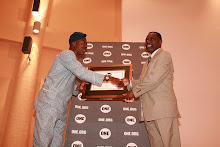
Kaduna, October 2008. Statistics on maternal, infant and child mortality show the situation in the north is far worse than in the southern parts of Nigeria. The maternal mortality rate in the north east (1549 in 100.000 life births) and the north west (1025 in 100.000) is more than five times as high as in the south west (165 in 100.000) . Hence, it is ever more necessary to raise public awareness on the grim condition of maternal health, the poor situation of many health facilities and the lack of accessibility to appropriate health care across Nigeria.
After the success of the first batch of Immersion Program Fellows, which reached its goal to educate a large number of journalists about maternal, newborn and child health issues, the project has been scaled up to train a new bunch of northern journalists. The approach looks at maternal mortality as a battlefield, in the same way war-reporters are embedded in the warfront, health reporters can be trained to be health experts in order to handle the complicated issues of health knowledgeably.
And who could fulfill this challenging task better than the media?
Seventeen journalists from all over the North were invited to a two-days orientation in the historical setting of Arewa House, Kaduna, and given the opportunity to be tutored by experts on health issues thereby increasing their reporting skills to create stories that directly affect the reader. Unfortunately, two of them had to be expelled due to lack of commitment. The first day was dedicated to information gathering, whereas the second day focused on the translation of the mere information into a grasping story.
The invited presenters, amongst them Dr. Oladapo Shittu from the Department of Obstetrics & Gynecology; Iyeme Efem, a health expert who spoke about Vaginal Fistulae; Augusta Akparanta-Emenogu, media specialist with ActionAID, Professor Emmanuel Otolorin from Access Project, Ms. Chinwe Onumonu from Pathfinder International and many other distinguished health professionals delivered informative presentations and never hesitated to engage themselves afterwards in discussions with the journalists. The participants had the opportunity to interview the experts and get exclusives voices for their health broadcasts.
It was pointed out, that the Millennium Development Goals 4 & 5, which focus on maternal and child health, are still out of reach and could only be advanced by huge improvements of the health sector. Participants advocated for the abolition of user fees for pregnant women and children under five; increased number of skilled birth attendants; improved access to health services especially in rural areas; implementation of a national health insurance .
It was noted that one player, be it the government or anybody else, can never reach these targets on its own. What Nigeria needs is a multi-sectoral partnership between a government which is committed to health policy, professional organizations keeping track of the spending of funds, an active civil society demanding their rights to access high-quality health care and last, but not least an investigative media environment, passing on information to every household and as a watchdog to the government of its promise
Budget tracking to ensure that funds allocated to health reach the communities is one more essential aspect of critical journalism.
The aim of this workshop was to train the journalists to live up to the desired change towards establishing a critical and investigative media environment, which can translate medical information and especially medical vocabulary into a language comprehensible to the lay audience. As Iyeme Efem put it in words, stressing the responsibility of the media :
“A responsible media person first learns about the issues, then highlights the issues and thereby generates dialogue between health providers and “consumers”, maintains the issues on the front burner and advocates for the voiceless and marginalized.”
Journalism is not only about reporting daily news, there must be a commitment to follow up with policy makers and continuously reminding them of the unsolved problems.
Only after the issue is resolved, the journalist’s job is done.


No comments:
Post a Comment